Maths Assignment: Calculus, Algebra, and Complex Numbers Solutions
VerifiedAdded on 2020/06/05
|18
|3603
|46
Homework Assignment
AI Summary
This document provides a comprehensive set of solutions to a maths assignment, covering a range of topics including calculus, algebra, complex numbers, vectors, and probability. The solutions are detailed and include step-by-step explanations for each problem. Questions involve finding values of trigonometric functions, solving equations, finding inverse functions, calculating derivatives and integrals, solving systems of equations, working with matrices, finding eigenvalues and eigenvectors, and calculating probabilities. Furthermore, the assignment delves into applications such as oil spills, differentials, circuit analysis, and area/volume calculations. The solutions are well-structured and presented, making them a valuable resource for students studying mathematics and seeking assistance with their assignments.
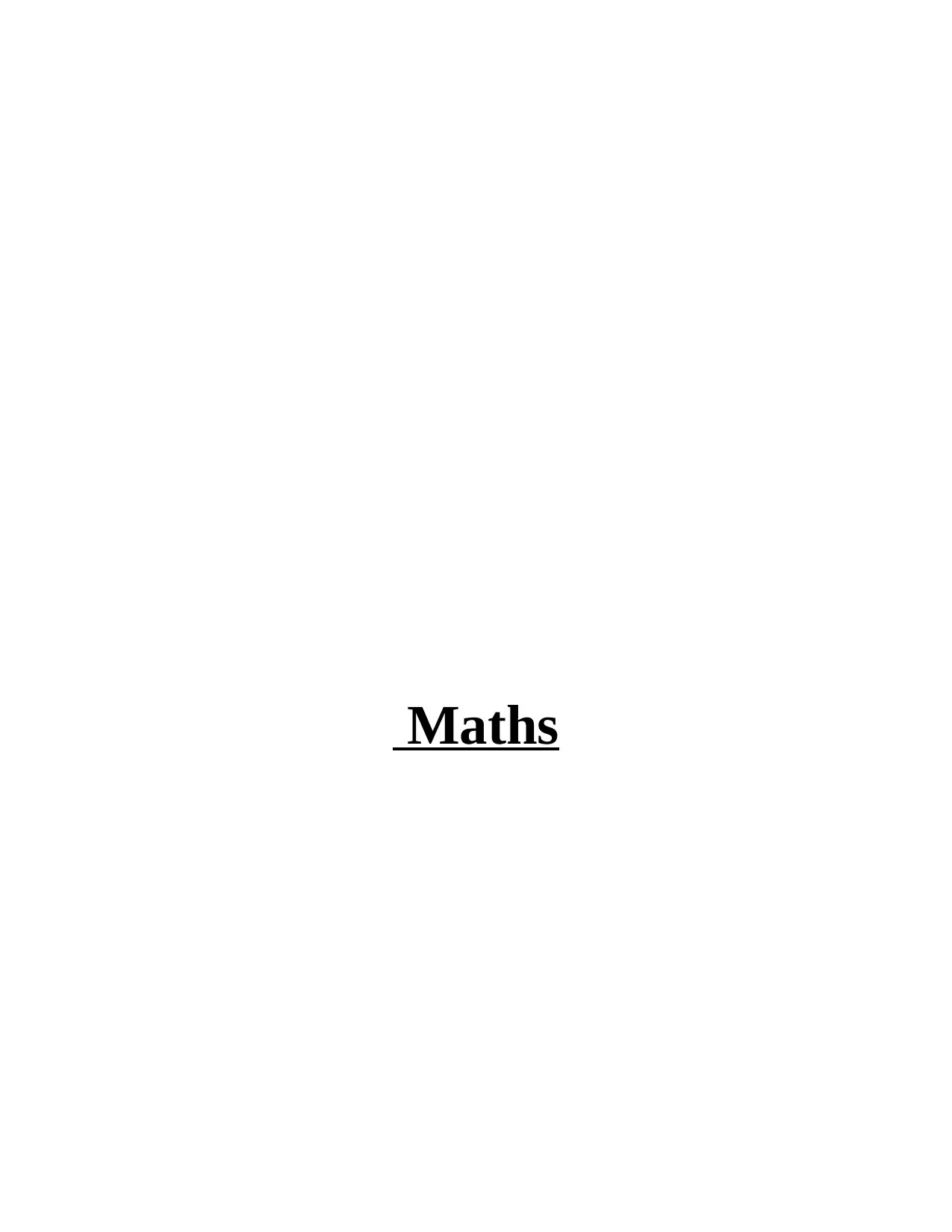
Maths
Paraphrase This Document
Need a fresh take? Get an instant paraphrase of this document with our AI Paraphraser
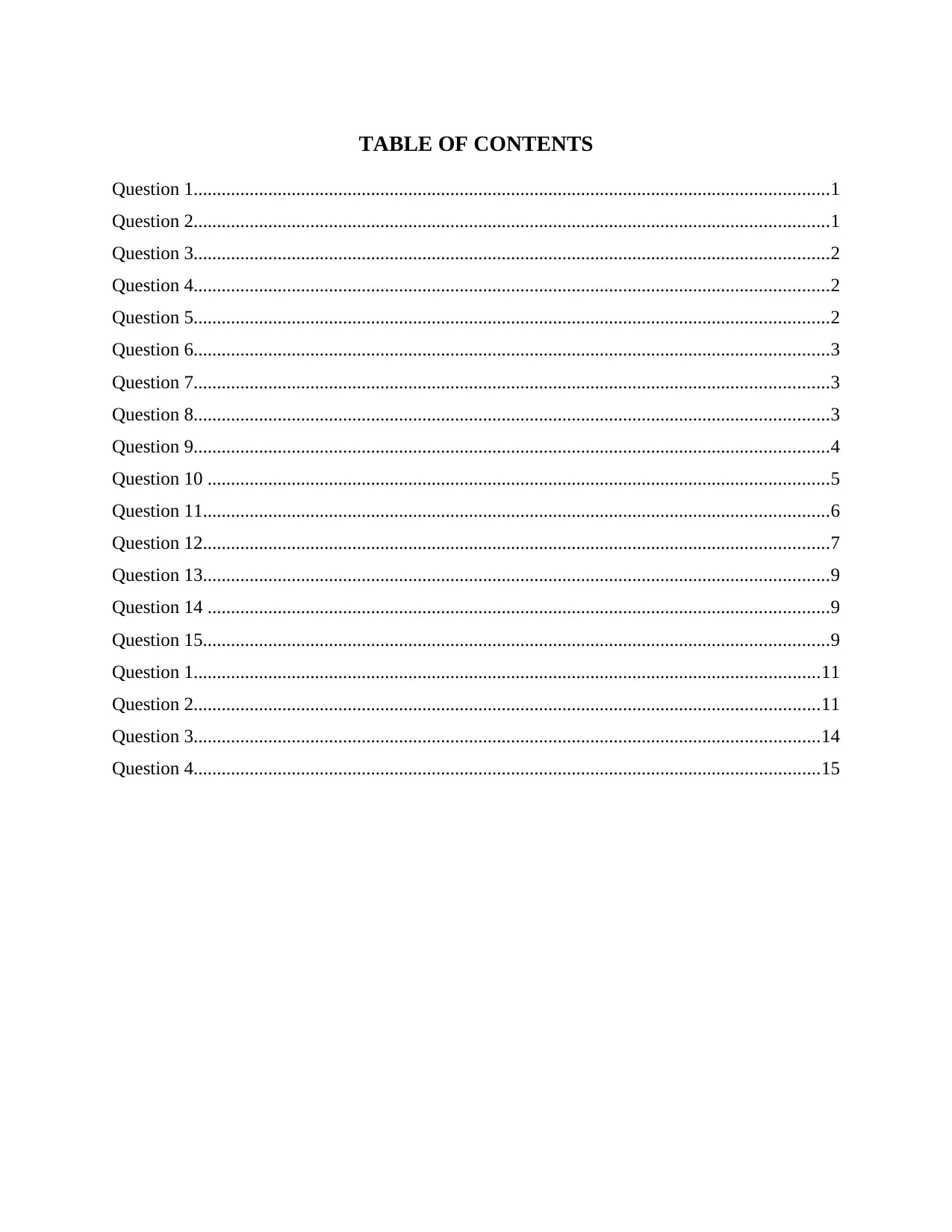
TABLE OF CONTENTS
Question 1........................................................................................................................................1
Question 2........................................................................................................................................1
Question 3........................................................................................................................................2
Question 4........................................................................................................................................2
Question 5........................................................................................................................................2
Question 6........................................................................................................................................3
Question 7........................................................................................................................................3
Question 8........................................................................................................................................3
Question 9........................................................................................................................................4
Question 10 .....................................................................................................................................5
Question 11......................................................................................................................................6
Question 12......................................................................................................................................7
Question 13......................................................................................................................................9
Question 14 .....................................................................................................................................9
Question 15......................................................................................................................................9
Question 1......................................................................................................................................11
Question 2......................................................................................................................................11
Question 3......................................................................................................................................14
Question 4......................................................................................................................................15
Question 1........................................................................................................................................1
Question 2........................................................................................................................................1
Question 3........................................................................................................................................2
Question 4........................................................................................................................................2
Question 5........................................................................................................................................2
Question 6........................................................................................................................................3
Question 7........................................................................................................................................3
Question 8........................................................................................................................................3
Question 9........................................................................................................................................4
Question 10 .....................................................................................................................................5
Question 11......................................................................................................................................6
Question 12......................................................................................................................................7
Question 13......................................................................................................................................9
Question 14 .....................................................................................................................................9
Question 15......................................................................................................................................9
Question 1......................................................................................................................................11
Question 2......................................................................................................................................11
Question 3......................................................................................................................................14
Question 4......................................................................................................................................15
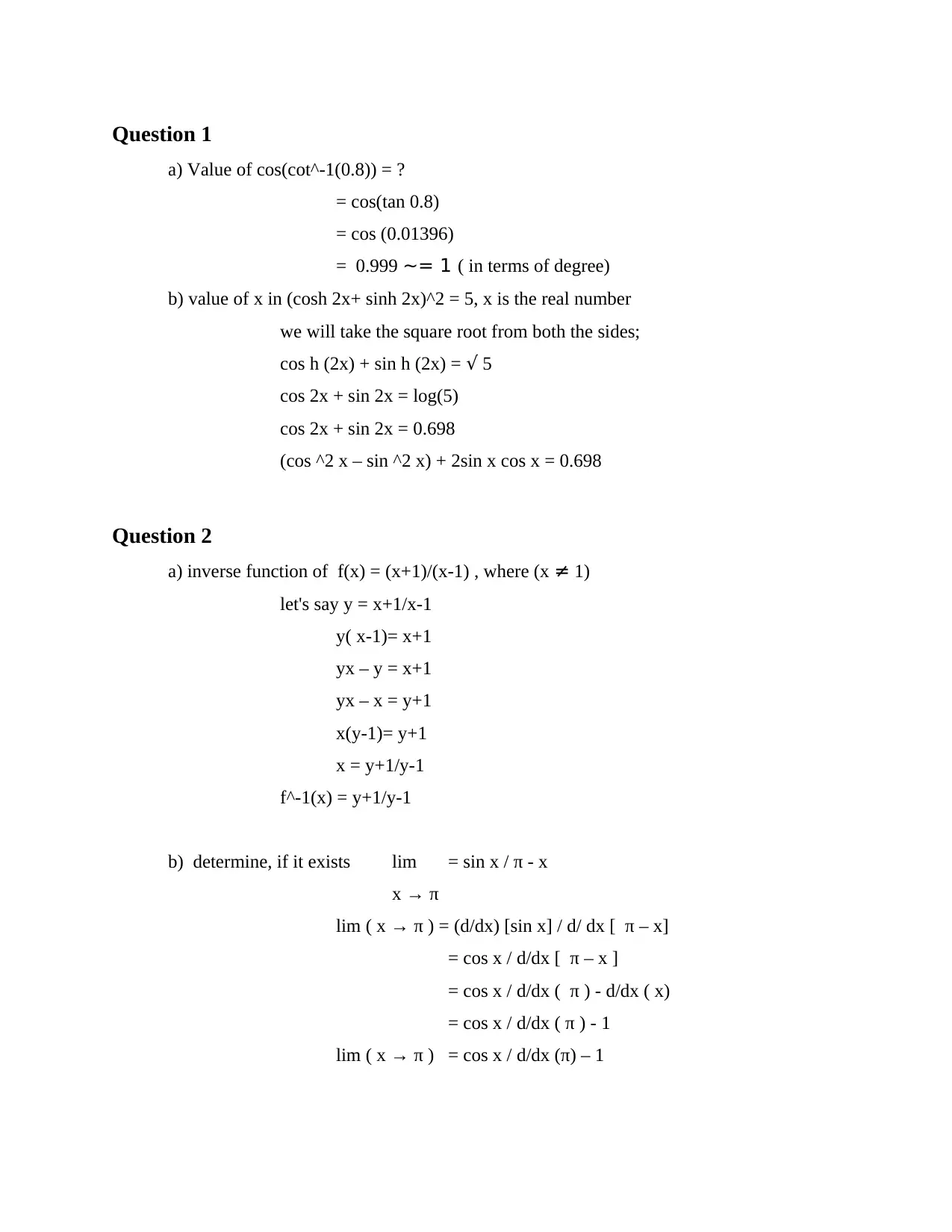
Question 1
a) Value of cos(cot^-1(0.8)) = ?
= cos(tan 0.8)
= cos (0.01396)
= 0.999 ~= 1 ( in terms of degree)
b) value of x in (cosh 2x+ sinh 2x)^2 = 5, x is the real number
we will take the square root from both the sides;
cos h (2x) + sin h (2x) = √ 5
cos 2x + sin 2x = log(5)
cos 2x + sin 2x = 0.698
(cos ^2 x – sin ^2 x) + 2sin x cos x = 0.698
Question 2
a) inverse function of f(x) = (x+1)/(x-1) , where (x ≠ 1)
let's say y = x+1/x-1
y( x-1)= x+1
yx – y = x+1
yx – x = y+1
x(y-1)= y+1
x = y+1/y-1
f^-1(x) = y+1/y-1
b) determine, if it exists lim = sin x / π - x
x → π
lim ( x → π ) = (d/dx) [sin x] / d/ dx [ π – x]
= cos x / d/dx [ π – x ]
= cos x / d/dx ( π ) - d/dx ( x)
= cos x / d/dx ( π ) - 1
lim ( x → π ) = cos x / d/dx (π) – 1
a) Value of cos(cot^-1(0.8)) = ?
= cos(tan 0.8)
= cos (0.01396)
= 0.999 ~= 1 ( in terms of degree)
b) value of x in (cosh 2x+ sinh 2x)^2 = 5, x is the real number
we will take the square root from both the sides;
cos h (2x) + sin h (2x) = √ 5
cos 2x + sin 2x = log(5)
cos 2x + sin 2x = 0.698
(cos ^2 x – sin ^2 x) + 2sin x cos x = 0.698
Question 2
a) inverse function of f(x) = (x+1)/(x-1) , where (x ≠ 1)
let's say y = x+1/x-1
y( x-1)= x+1
yx – y = x+1
yx – x = y+1
x(y-1)= y+1
x = y+1/y-1
f^-1(x) = y+1/y-1
b) determine, if it exists lim = sin x / π - x
x → π
lim ( x → π ) = (d/dx) [sin x] / d/ dx [ π – x]
= cos x / d/dx [ π – x ]
= cos x / d/dx ( π ) - d/dx ( x)
= cos x / d/dx ( π ) - 1
lim ( x → π ) = cos x / d/dx (π) – 1
⊘ This is a preview!⊘
Do you want full access?
Subscribe today to unlock all pages.

Trusted by 1+ million students worldwide
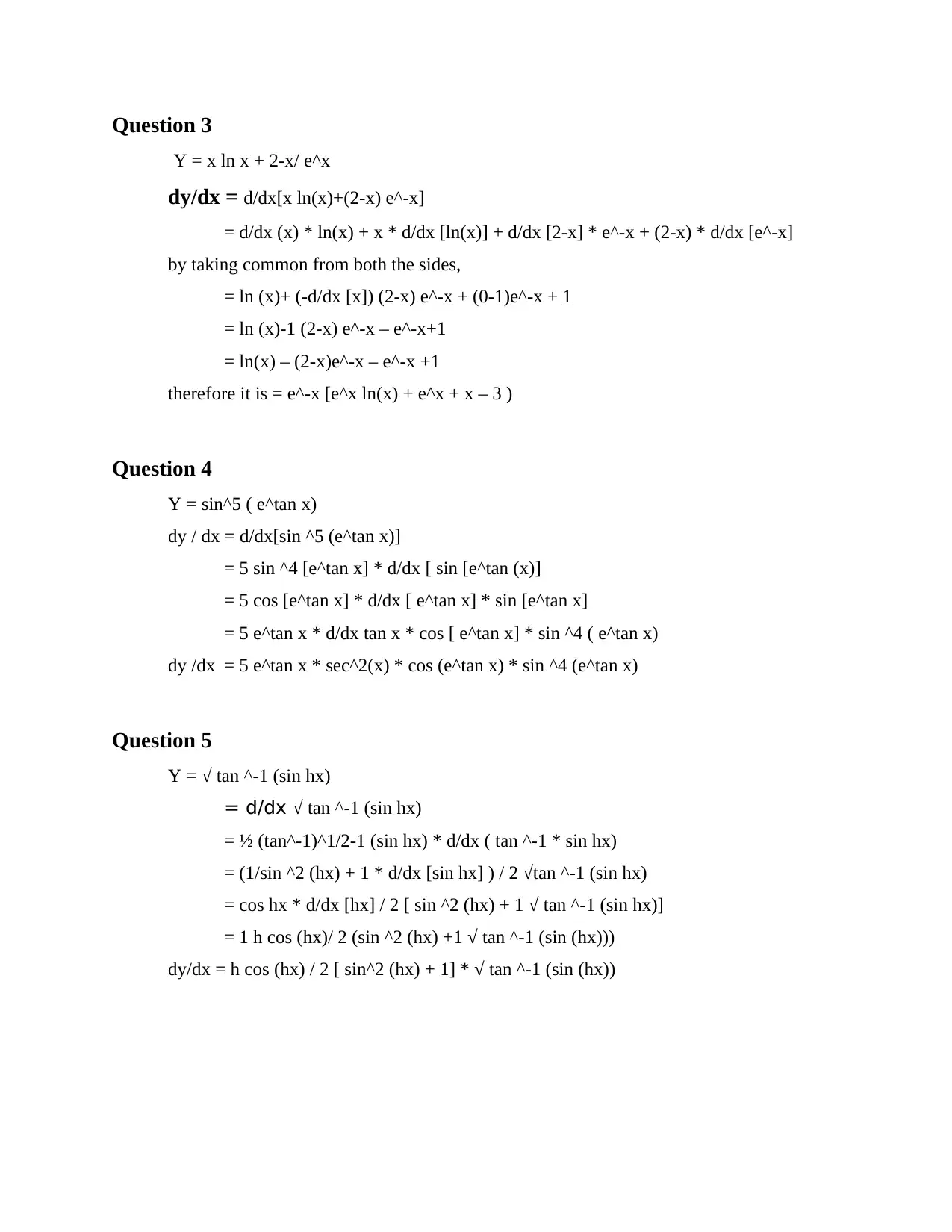
Question 3
Y = x ln x + 2-x/ e^x
dy/dx = d/dx[x ln(x)+(2-x) e^-x]
= d/dx (x) * ln(x) + x * d/dx [ln(x)] + d/dx [2-x] * e^-x + (2-x) * d/dx [e^-x]
by taking common from both the sides,
= ln (x)+ (-d/dx [x]) (2-x) e^-x + (0-1)e^-x + 1
= ln (x)-1 (2-x) e^-x – e^-x+1
= ln(x) – (2-x)e^-x – e^-x +1
therefore it is = e^-x [e^x ln(x) + e^x + x – 3 )
Question 4
Y = sin^5 ( e^tan x)
dy / dx = d/dx[sin ^5 (e^tan x)]
= 5 sin ^4 [e^tan x] * d/dx [ sin [e^tan (x)]
= 5 cos [e^tan x] * d/dx [ e^tan x] * sin [e^tan x]
= 5 e^tan x * d/dx tan x * cos [ e^tan x] * sin ^4 ( e^tan x)
dy /dx = 5 e^tan x * sec^2(x) * cos (e^tan x) * sin ^4 (e^tan x)
Question 5
Y = √ tan ^-1 (sin hx)
= d/dx √ tan ^-1 (sin hx)
= ½ (tan^-1)^1/2-1 (sin hx) * d/dx ( tan ^-1 * sin hx)
= (1/sin ^2 (hx) + 1 * d/dx [sin hx] ) / 2 √tan ^-1 (sin hx)
= cos hx * d/dx [hx] / 2 [ sin ^2 (hx) + 1 √ tan ^-1 (sin hx)]
= 1 h cos (hx)/ 2 (sin ^2 (hx) +1 √ tan ^-1 (sin (hx)))
dy/dx = h cos (hx) / 2 [ sin^2 (hx) + 1] * √ tan ^-1 (sin (hx))
Y = x ln x + 2-x/ e^x
dy/dx = d/dx[x ln(x)+(2-x) e^-x]
= d/dx (x) * ln(x) + x * d/dx [ln(x)] + d/dx [2-x] * e^-x + (2-x) * d/dx [e^-x]
by taking common from both the sides,
= ln (x)+ (-d/dx [x]) (2-x) e^-x + (0-1)e^-x + 1
= ln (x)-1 (2-x) e^-x – e^-x+1
= ln(x) – (2-x)e^-x – e^-x +1
therefore it is = e^-x [e^x ln(x) + e^x + x – 3 )
Question 4
Y = sin^5 ( e^tan x)
dy / dx = d/dx[sin ^5 (e^tan x)]
= 5 sin ^4 [e^tan x] * d/dx [ sin [e^tan (x)]
= 5 cos [e^tan x] * d/dx [ e^tan x] * sin [e^tan x]
= 5 e^tan x * d/dx tan x * cos [ e^tan x] * sin ^4 ( e^tan x)
dy /dx = 5 e^tan x * sec^2(x) * cos (e^tan x) * sin ^4 (e^tan x)
Question 5
Y = √ tan ^-1 (sin hx)
= d/dx √ tan ^-1 (sin hx)
= ½ (tan^-1)^1/2-1 (sin hx) * d/dx ( tan ^-1 * sin hx)
= (1/sin ^2 (hx) + 1 * d/dx [sin hx] ) / 2 √tan ^-1 (sin hx)
= cos hx * d/dx [hx] / 2 [ sin ^2 (hx) + 1 √ tan ^-1 (sin hx)]
= 1 h cos (hx)/ 2 (sin ^2 (hx) +1 √ tan ^-1 (sin (hx)))
dy/dx = h cos (hx) / 2 [ sin^2 (hx) + 1] * √ tan ^-1 (sin (hx))
Paraphrase This Document
Need a fresh take? Get an instant paraphrase of this document with our AI Paraphraser
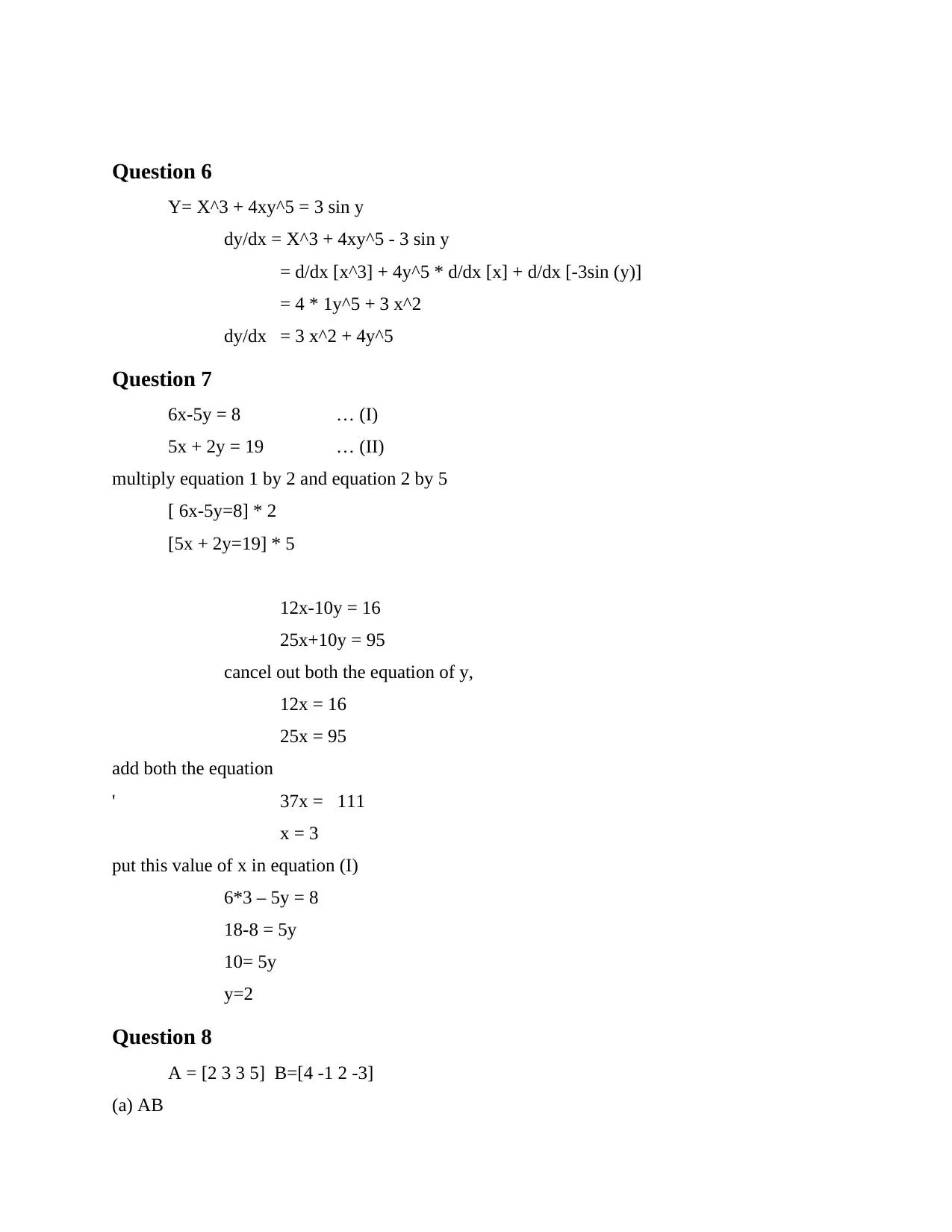
Question 6
Y= X^3 + 4xy^5 = 3 sin y
dy/dx = X^3 + 4xy^5 - 3 sin y
= d/dx [x^3] + 4y^5 * d/dx [x] + d/dx [-3sin (y)]
= 4 * 1y^5 + 3 x^2
dy/dx = 3 x^2 + 4y^5
Question 7
6x-5y = 8 … (I)
5x + 2y = 19 … (II)
multiply equation 1 by 2 and equation 2 by 5
[ 6x-5y=8] * 2
[5x + 2y=19] * 5
12x-10y = 16
25x+10y = 95
cancel out both the equation of y,
12x = 16
25x = 95
add both the equation
' 37x = 111
x = 3
put this value of x in equation (I)
6*3 – 5y = 8
18-8 = 5y
10= 5y
y=2
Question 8
A = [2 3 3 5] B=[4 -1 2 -3]
(a) AB
Y= X^3 + 4xy^5 = 3 sin y
dy/dx = X^3 + 4xy^5 - 3 sin y
= d/dx [x^3] + 4y^5 * d/dx [x] + d/dx [-3sin (y)]
= 4 * 1y^5 + 3 x^2
dy/dx = 3 x^2 + 4y^5
Question 7
6x-5y = 8 … (I)
5x + 2y = 19 … (II)
multiply equation 1 by 2 and equation 2 by 5
[ 6x-5y=8] * 2
[5x + 2y=19] * 5
12x-10y = 16
25x+10y = 95
cancel out both the equation of y,
12x = 16
25x = 95
add both the equation
' 37x = 111
x = 3
put this value of x in equation (I)
6*3 – 5y = 8
18-8 = 5y
10= 5y
y=2
Question 8
A = [2 3 3 5] B=[4 -1 2 -3]
(a) AB
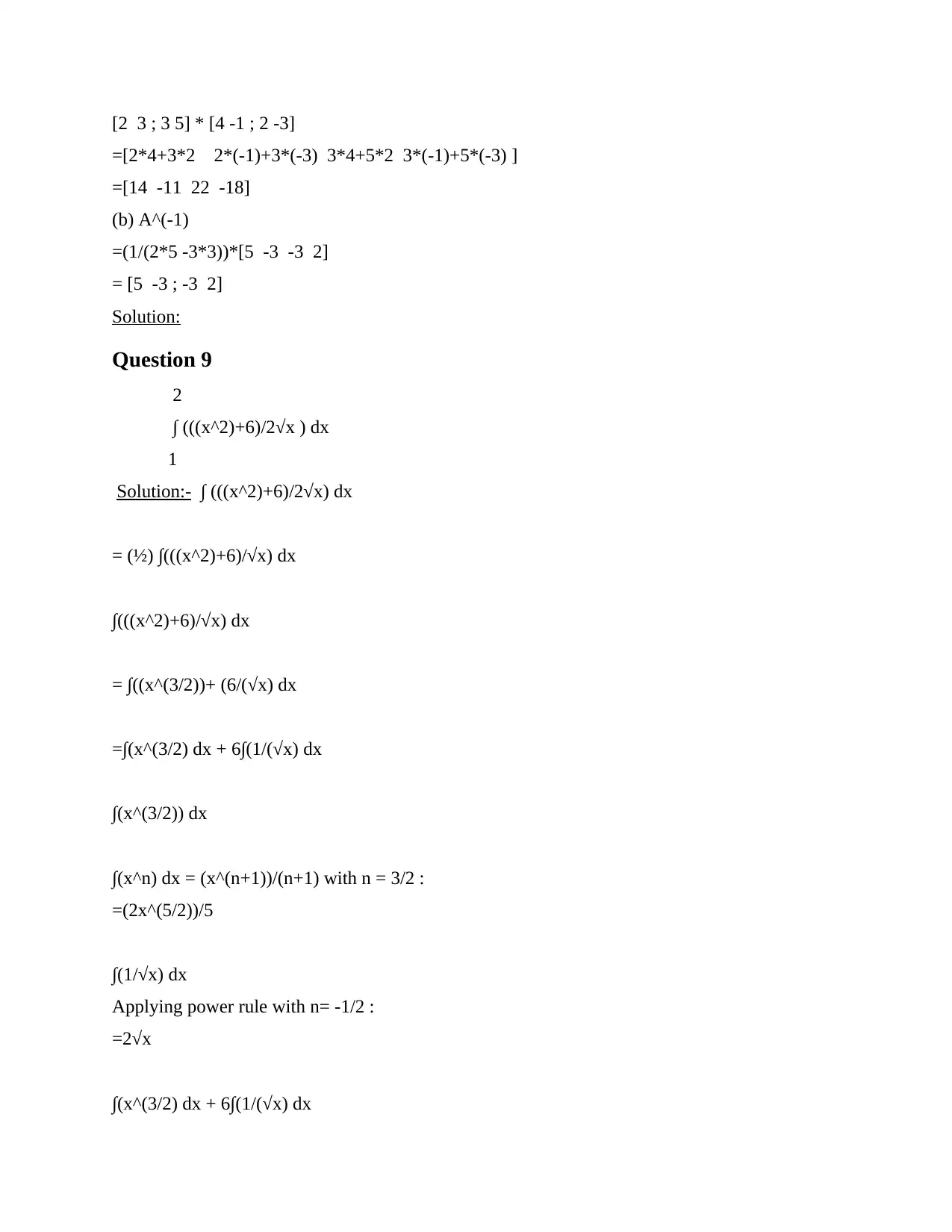
[2 3 ; 3 5] * [4 -1 ; 2 -3]
=[2*4+3*2 2*(-1)+3*(-3) 3*4+5*2 3*(-1)+5*(-3) ]
=[14 -11 22 -18]
(b) A^(-1)
=(1/(2*5 -3*3))*[5 -3 -3 2]
= [5 -3 ; -3 2]
Solution:
Question 9
2
∫ (((x^2)+6)/2√x ) dx
1
Solution:- ∫ (((x^2)+6)/2√x) dx
= (½) ∫(((x^2)+6)/√x) dx
∫(((x^2)+6)/√x) dx
= ∫((x^(3/2))+ (6/(√x) dx
=∫(x^(3/2) dx + 6∫(1/(√x) dx
∫(x^(3/2)) dx
∫(x^n) dx = (x^(n+1))/(n+1) with n = 3/2 :
=(2x^(5/2))/5
∫(1/√x) dx
Applying power rule with n= -1/2 :
=2√x
∫(x^(3/2) dx + 6∫(1/(√x) dx
=[2*4+3*2 2*(-1)+3*(-3) 3*4+5*2 3*(-1)+5*(-3) ]
=[14 -11 22 -18]
(b) A^(-1)
=(1/(2*5 -3*3))*[5 -3 -3 2]
= [5 -3 ; -3 2]
Solution:
Question 9
2
∫ (((x^2)+6)/2√x ) dx
1
Solution:- ∫ (((x^2)+6)/2√x) dx
= (½) ∫(((x^2)+6)/√x) dx
∫(((x^2)+6)/√x) dx
= ∫((x^(3/2))+ (6/(√x) dx
=∫(x^(3/2) dx + 6∫(1/(√x) dx
∫(x^(3/2)) dx
∫(x^n) dx = (x^(n+1))/(n+1) with n = 3/2 :
=(2x^(5/2))/5
∫(1/√x) dx
Applying power rule with n= -1/2 :
=2√x
∫(x^(3/2) dx + 6∫(1/(√x) dx
⊘ This is a preview!⊘
Do you want full access?
Subscribe today to unlock all pages.

Trusted by 1+ million students worldwide

= (2x^(5/2))/5 + 12√x
(½) ∫(((x^2)+6)/√x) dx
=(x^(5/2))/5 + 6√x
∫ (((x^2)+6)/2√x) dx
=(x^(5/2))/5 + 6√x +C
=(√x(x^2 + 30))/10 + C
2
∫ f(x) dx = (17.2^(5/2) – 62)/10
1
Approximation : 3.416652224137046
Question 10
∫((e^tan x) / (cos^2 x)) dx
Solution:
= ∫e^(tan(x)) sec^2 (x) dx
Substituting u = tan(x) → du/dx = sec^2(x)
= ∫e^u du
=e^u
u = tan(x) :
= e^tan(x)
= e^tan(x) + C
Question 11
∫x^2*sin(2x) dx
∫fg' = fg - ∫f'g
(½) ∫(((x^2)+6)/√x) dx
=(x^(5/2))/5 + 6√x
∫ (((x^2)+6)/2√x) dx
=(x^(5/2))/5 + 6√x +C
=(√x(x^2 + 30))/10 + C
2
∫ f(x) dx = (17.2^(5/2) – 62)/10
1
Approximation : 3.416652224137046
Question 10
∫((e^tan x) / (cos^2 x)) dx
Solution:
= ∫e^(tan(x)) sec^2 (x) dx
Substituting u = tan(x) → du/dx = sec^2(x)
= ∫e^u du
=e^u
u = tan(x) :
= e^tan(x)
= e^tan(x) + C
Question 11
∫x^2*sin(2x) dx
∫fg' = fg - ∫f'g
Paraphrase This Document
Need a fresh take? Get an instant paraphrase of this document with our AI Paraphraser
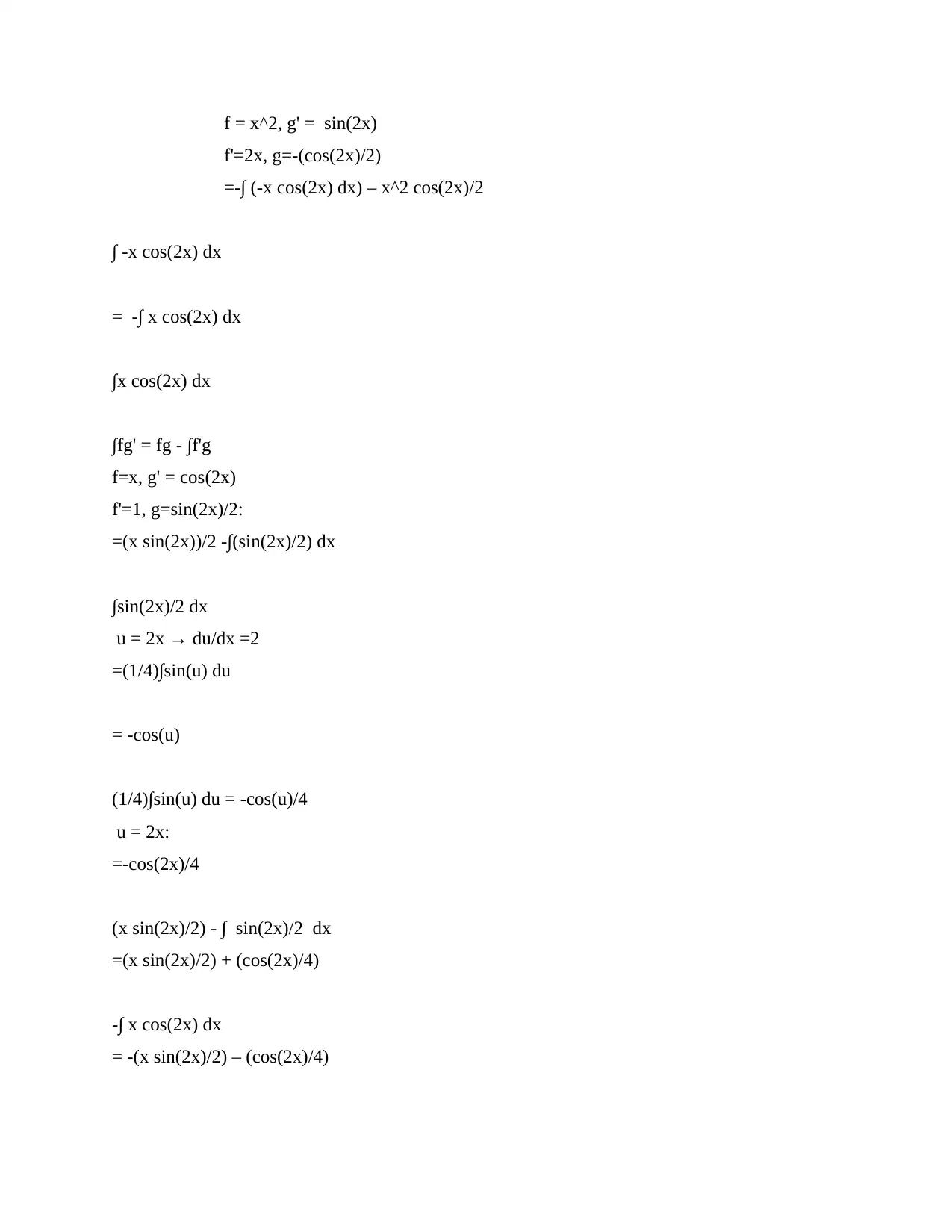
f = x^2, g' = sin(2x)
f'=2x, g=-(cos(2x)/2)
=-∫ (-x cos(2x) dx) – x^2 cos(2x)/2
∫ -x cos(2x) dx
= -∫ x cos(2x) dx
∫x cos(2x) dx
∫fg' = fg - ∫f'g
f=x, g' = cos(2x)
f'=1, g=sin(2x)/2:
=(x sin(2x))/2 -∫(sin(2x)/2) dx
∫sin(2x)/2 dx
u = 2x → du/dx =2
=(1/4)∫sin(u) du
= -cos(u)
(1/4)∫sin(u) du = -cos(u)/4
u = 2x:
=-cos(2x)/4
(x sin(2x)/2) - ∫ sin(2x)/2 dx
=(x sin(2x)/2) + (cos(2x)/4)
-∫ x cos(2x) dx
= -(x sin(2x)/2) – (cos(2x)/4)
f'=2x, g=-(cos(2x)/2)
=-∫ (-x cos(2x) dx) – x^2 cos(2x)/2
∫ -x cos(2x) dx
= -∫ x cos(2x) dx
∫x cos(2x) dx
∫fg' = fg - ∫f'g
f=x, g' = cos(2x)
f'=1, g=sin(2x)/2:
=(x sin(2x))/2 -∫(sin(2x)/2) dx
∫sin(2x)/2 dx
u = 2x → du/dx =2
=(1/4)∫sin(u) du
= -cos(u)
(1/4)∫sin(u) du = -cos(u)/4
u = 2x:
=-cos(2x)/4
(x sin(2x)/2) - ∫ sin(2x)/2 dx
=(x sin(2x)/2) + (cos(2x)/4)
-∫ x cos(2x) dx
= -(x sin(2x)/2) – (cos(2x)/4)

-∫ - x cos(2x) dx – (x^2 cos(2x)/2)
=(x sin(2x)/2) - (x^2 cos(2x)/2) + (cos(2x)/4)
=(2x sin(2x) + (1-2x^2) cos(2x))/4 + C
Question 12
∫(1-x)/(x^2 +6x+8) dx
−(x−1) / ((x+2)(x+4))
∫(1-x)/(x^2 +6x+8) dx
=-∫(x-1)/(x^2 +6x+8) dx
∫(x-1)/(x^2 +6x+8) dx
Write x-1 as (1/2)(2x+6) + (-4) and split:
= ∫(((2x+6)/(2(x^2+6x+8))) – (4/(x^2 +6x +8))) dx
=∫((x+3)/(x^2 +6x+8)) dx – 4 ∫1/(x^2 + 6x +8 ) dx
Now solving :
∫((x+3)/(x^2 +6x+8)) dx
u = x^2 + 6x + 8 → du/dx = 2x + 6
=(1/2)∫(1/u) du
∫(1/u) du
=ln(u)
(1/2)∫(1/u) du
=ln(u)/2
u= x^2 + 6x + 8 :
= (ln(x^2+6x+8))/2
=(x sin(2x)/2) - (x^2 cos(2x)/2) + (cos(2x)/4)
=(2x sin(2x) + (1-2x^2) cos(2x))/4 + C
Question 12
∫(1-x)/(x^2 +6x+8) dx
−(x−1) / ((x+2)(x+4))
∫(1-x)/(x^2 +6x+8) dx
=-∫(x-1)/(x^2 +6x+8) dx
∫(x-1)/(x^2 +6x+8) dx
Write x-1 as (1/2)(2x+6) + (-4) and split:
= ∫(((2x+6)/(2(x^2+6x+8))) – (4/(x^2 +6x +8))) dx
=∫((x+3)/(x^2 +6x+8)) dx – 4 ∫1/(x^2 + 6x +8 ) dx
Now solving :
∫((x+3)/(x^2 +6x+8)) dx
u = x^2 + 6x + 8 → du/dx = 2x + 6
=(1/2)∫(1/u) du
∫(1/u) du
=ln(u)
(1/2)∫(1/u) du
=ln(u)/2
u= x^2 + 6x + 8 :
= (ln(x^2+6x+8))/2
⊘ This is a preview!⊘
Do you want full access?
Subscribe today to unlock all pages.

Trusted by 1+ million students worldwide
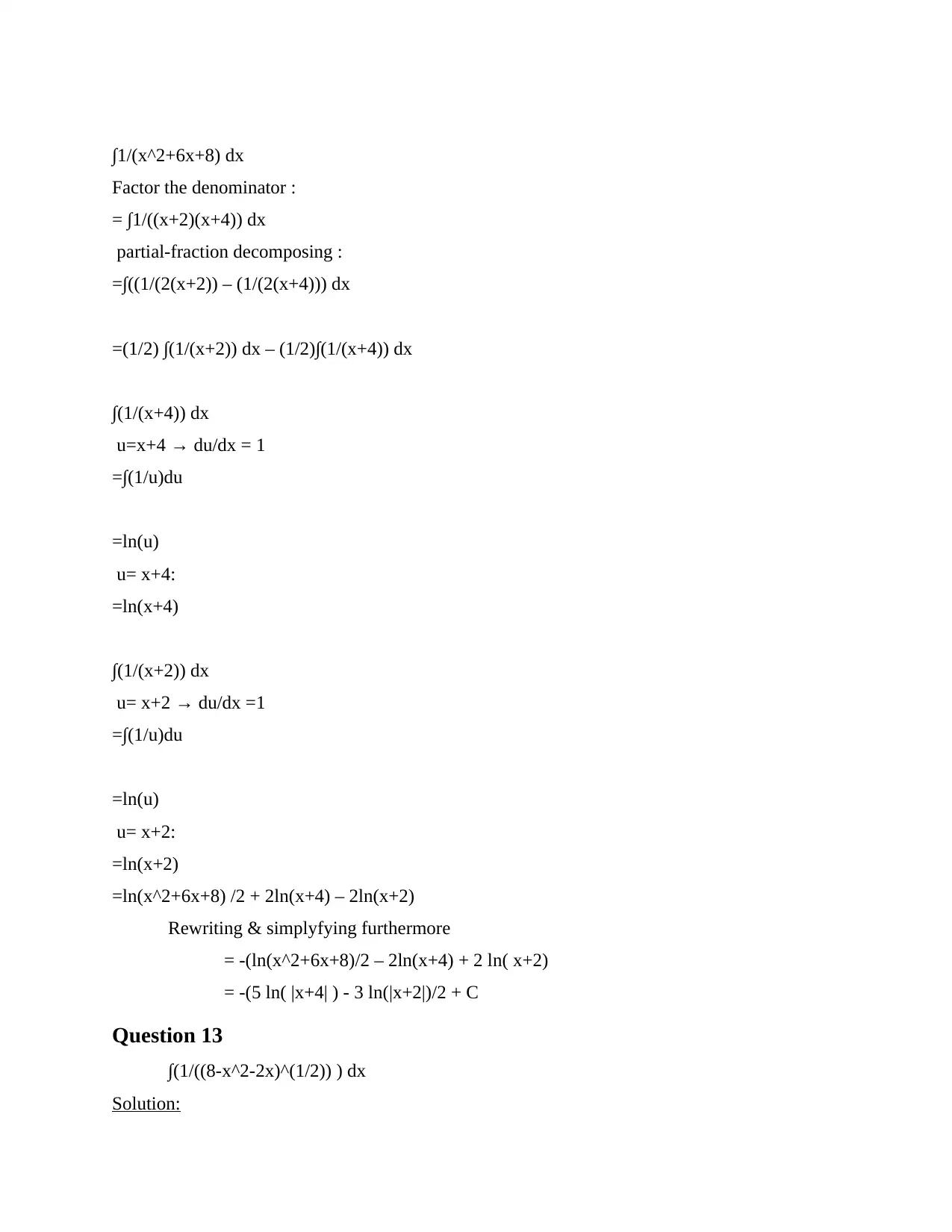
∫1/(x^2+6x+8) dx
Factor the denominator :
= ∫1/((x+2)(x+4)) dx
partial-fraction decomposing :
=∫((1/(2(x+2)) – (1/(2(x+4))) dx
=(1/2) ∫(1/(x+2)) dx – (1/2)∫(1/(x+4)) dx
∫(1/(x+4)) dx
u=x+4 → du/dx = 1
=∫(1/u)du
=ln(u)
u= x+4:
=ln(x+4)
∫(1/(x+2)) dx
u= x+2 → du/dx =1
=∫(1/u)du
=ln(u)
u= x+2:
=ln(x+2)
=ln(x^2+6x+8) /2 + 2ln(x+4) – 2ln(x+2)
Rewriting & simplyfying furthermore
= -(ln(x^2+6x+8)/2 – 2ln(x+4) + 2 ln( x+2)
= -(5 ln( |x+4| ) - 3 ln(|x+2|)/2 + C
Question 13
∫(1/((8-x^2-2x)^(1/2)) ) dx
Solution:
Factor the denominator :
= ∫1/((x+2)(x+4)) dx
partial-fraction decomposing :
=∫((1/(2(x+2)) – (1/(2(x+4))) dx
=(1/2) ∫(1/(x+2)) dx – (1/2)∫(1/(x+4)) dx
∫(1/(x+4)) dx
u=x+4 → du/dx = 1
=∫(1/u)du
=ln(u)
u= x+4:
=ln(x+4)
∫(1/(x+2)) dx
u= x+2 → du/dx =1
=∫(1/u)du
=ln(u)
u= x+2:
=ln(x+2)
=ln(x^2+6x+8) /2 + 2ln(x+4) – 2ln(x+2)
Rewriting & simplyfying furthermore
= -(ln(x^2+6x+8)/2 – 2ln(x+4) + 2 ln( x+2)
= -(5 ln( |x+4| ) - 3 ln(|x+2|)/2 + C
Question 13
∫(1/((8-x^2-2x)^(1/2)) ) dx
Solution:
Paraphrase This Document
Need a fresh take? Get an instant paraphrase of this document with our AI Paraphraser
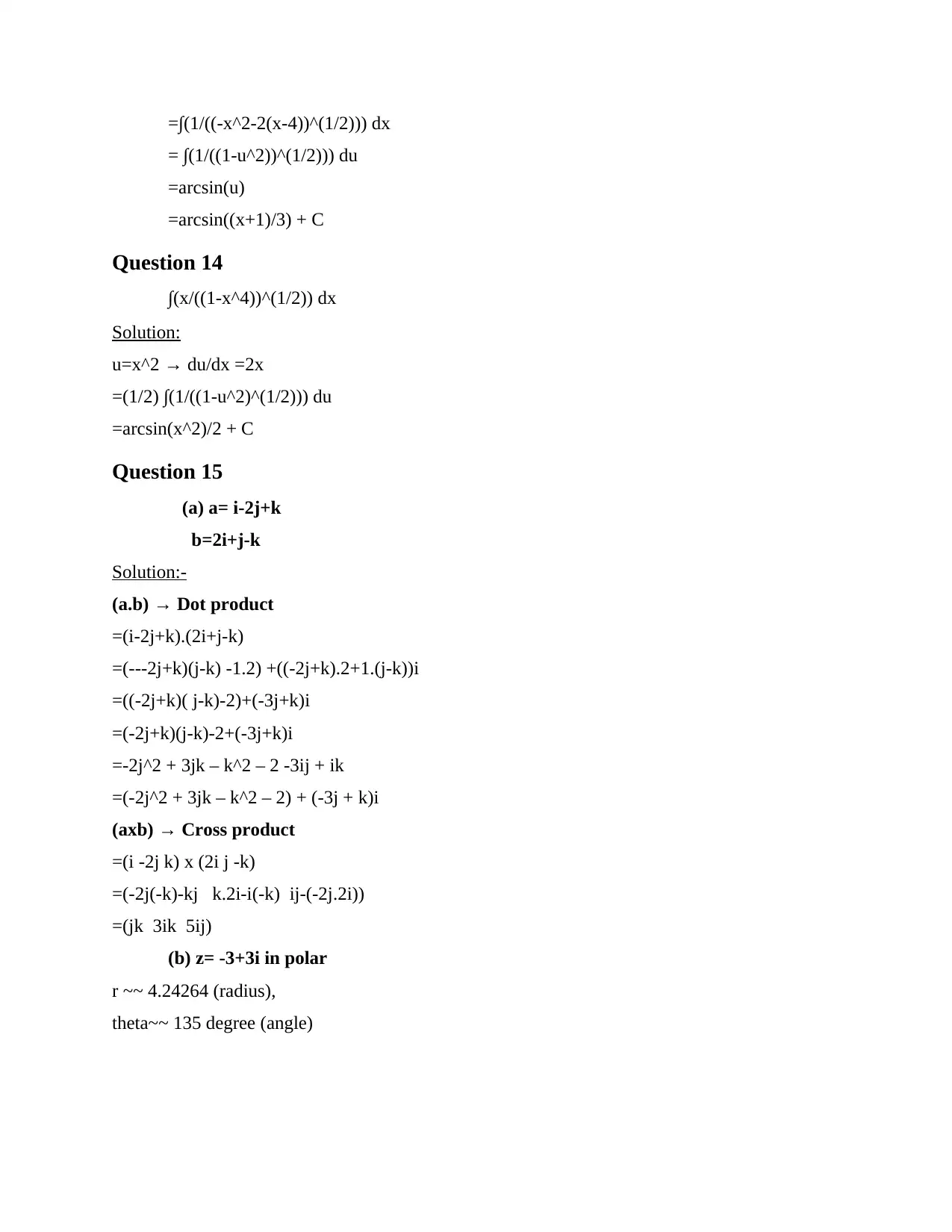
=∫(1/((-x^2-2(x-4))^(1/2))) dx
= ∫(1/((1-u^2))^(1/2))) du
=arcsin(u)
=arcsin((x+1)/3) + C
Question 14
∫(x/((1-x^4))^(1/2)) dx
Solution:
u=x^2 → du/dx =2x
=(1/2) ∫(1/((1-u^2)^(1/2))) du
=arcsin(x^2)/2 + C
Question 15
(a) a= i-2j+k
b=2i+j-k
Solution:-
(a.b) → Dot product
=(i-2j+k).(2i+j-k)
=(---2j+k)(j-k) -1.2) +((-2j+k).2+1.(j-k))i
=((-2j+k)( j-k)-2)+(-3j+k)i
=(-2j+k)(j-k)-2+(-3j+k)i
=-2j^2 + 3jk – k^2 – 2 -3ij + ik
=(-2j^2 + 3jk – k^2 – 2) + (-3j + k)i
(axb) → Cross product
=(i -2j k) x (2i j -k)
=(-2j(-k)-kj k.2i-i(-k) ij-(-2j.2i))
=(jk 3ik 5ij)
(b) z= -3+3i in polar
r ~~ 4.24264 (radius),
theta~~ 135 degree (angle)
= ∫(1/((1-u^2))^(1/2))) du
=arcsin(u)
=arcsin((x+1)/3) + C
Question 14
∫(x/((1-x^4))^(1/2)) dx
Solution:
u=x^2 → du/dx =2x
=(1/2) ∫(1/((1-u^2)^(1/2))) du
=arcsin(x^2)/2 + C
Question 15
(a) a= i-2j+k
b=2i+j-k
Solution:-
(a.b) → Dot product
=(i-2j+k).(2i+j-k)
=(---2j+k)(j-k) -1.2) +((-2j+k).2+1.(j-k))i
=((-2j+k)( j-k)-2)+(-3j+k)i
=(-2j+k)(j-k)-2+(-3j+k)i
=-2j^2 + 3jk – k^2 – 2 -3ij + ik
=(-2j^2 + 3jk – k^2 – 2) + (-3j + k)i
(axb) → Cross product
=(i -2j k) x (2i j -k)
=(-2j(-k)-kj k.2i-i(-k) ij-(-2j.2i))
=(jk 3ik 5ij)
(b) z= -3+3i in polar
r ~~ 4.24264 (radius),
theta~~ 135 degree (angle)
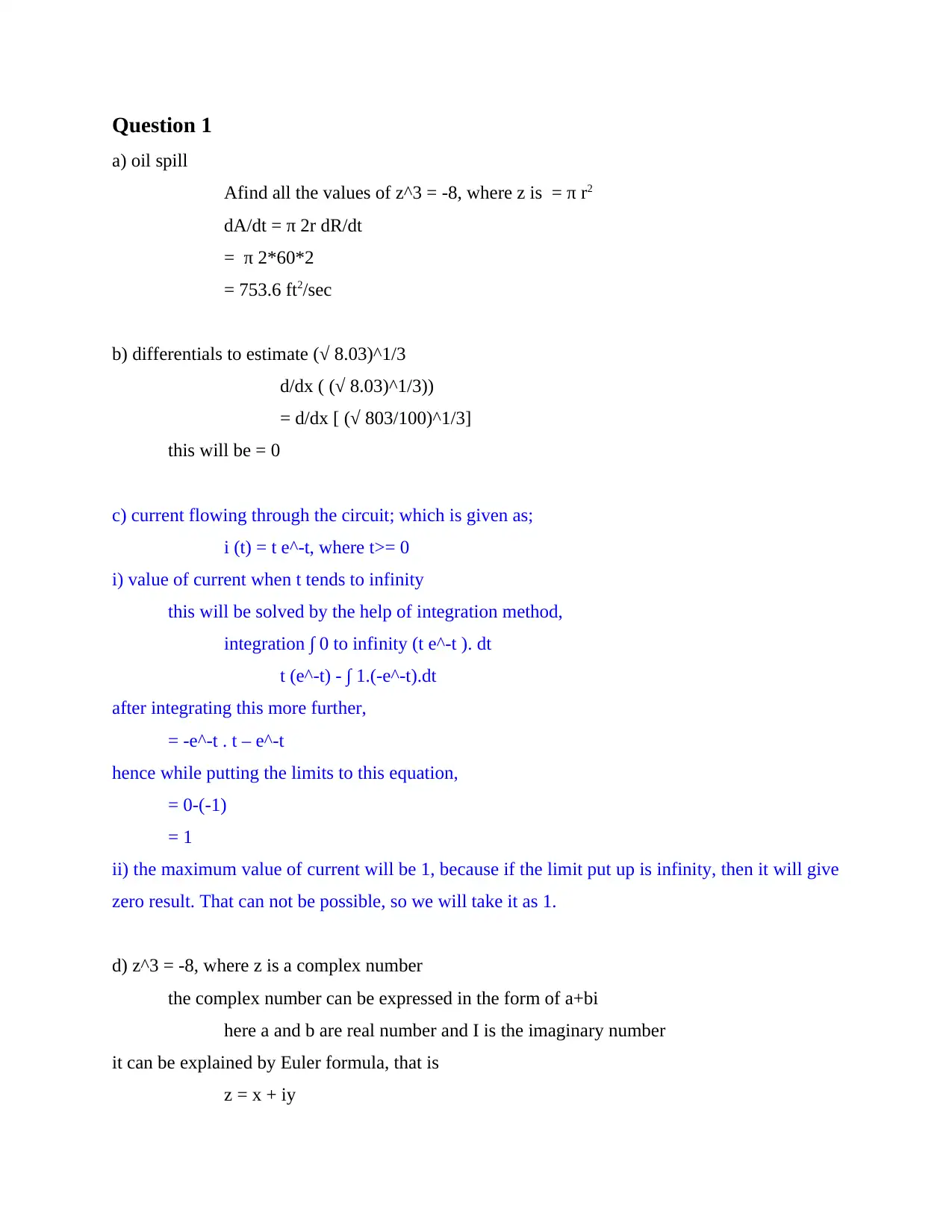
Question 1
a) oil spill
Afind all the values of z^3 = -8, where z is = π r2
dA/dt = π 2r dR/dt
= π 2*60*2
= 753.6 ft2/sec
b) differentials to estimate (√ 8.03)^1/3
d/dx ( (√ 8.03)^1/3))
= d/dx [ (√ 803/100)^1/3]
this will be = 0
c) current flowing through the circuit; which is given as;
i (t) = t e^-t, where t>= 0
i) value of current when t tends to infinity
this will be solved by the help of integration method,
integration ∫ 0 to infinity (t e^-t ). dt
t (e^-t) - ∫ 1.(-e^-t).dt
after integrating this more further,
= -e^-t . t – e^-t
hence while putting the limits to this equation,
= 0-(-1)
= 1
ii) the maximum value of current will be 1, because if the limit put up is infinity, then it will give
zero result. That can not be possible, so we will take it as 1.
d) z^3 = -8, where z is a complex number
the complex number can be expressed in the form of a+bi
here a and b are real number and I is the imaginary number
it can be explained by Euler formula, that is
z = x + iy
a) oil spill
Afind all the values of z^3 = -8, where z is = π r2
dA/dt = π 2r dR/dt
= π 2*60*2
= 753.6 ft2/sec
b) differentials to estimate (√ 8.03)^1/3
d/dx ( (√ 8.03)^1/3))
= d/dx [ (√ 803/100)^1/3]
this will be = 0
c) current flowing through the circuit; which is given as;
i (t) = t e^-t, where t>= 0
i) value of current when t tends to infinity
this will be solved by the help of integration method,
integration ∫ 0 to infinity (t e^-t ). dt
t (e^-t) - ∫ 1.(-e^-t).dt
after integrating this more further,
= -e^-t . t – e^-t
hence while putting the limits to this equation,
= 0-(-1)
= 1
ii) the maximum value of current will be 1, because if the limit put up is infinity, then it will give
zero result. That can not be possible, so we will take it as 1.
d) z^3 = -8, where z is a complex number
the complex number can be expressed in the form of a+bi
here a and b are real number and I is the imaginary number
it can be explained by Euler formula, that is
z = x + iy
⊘ This is a preview!⊘
Do you want full access?
Subscribe today to unlock all pages.

Trusted by 1+ million students worldwide
1 out of 18
Related Documents
Your All-in-One AI-Powered Toolkit for Academic Success.
+13062052269
info@desklib.com
Available 24*7 on WhatsApp / Email
![[object Object]](/_next/static/media/star-bottom.7253800d.svg)
Unlock your academic potential
Copyright © 2020–2025 A2Z Services. All Rights Reserved. Developed and managed by ZUCOL.




